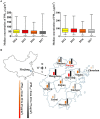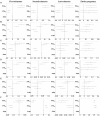Combined exposure to PM2.5 and PM10 in reductions of physiological development among preterm birth: a retrospective study from 2014 to 2017 in China
- PMID: 37564430
- PMCID: PMC10410271
- DOI: 10.3389/fpubh.2023.1146283
Combined exposure to PM2.5 and PM10 in reductions of physiological development among preterm birth: a retrospective study from 2014 to 2017 in China
Abstract
Background: Preterm birth (PTB) has been linked with ambient particulate matter (PM) exposure. However, data are limited between physiological development of PTB and PM exposure.
Methods: Trimester and season-specific PM exposure including PM2.5 and PM10 was collected from Jiaxing between January 2014 and December 2017. Information about parents and 3,054 PTB (gestational age < 37 weeks) outcomes such as weight (g), head circumference (cm), chest circumference (cm), height (cm) and Apgar 5 score were obtained from birth records. We used generalized linear models to assess the relationship between PTB physiological developmental indices and PM2.5, PM10 and their combined exposures. A binary logistic regression model was performed to assess the association between exposures and low birth weight (LBW, < 2,500 g).
Results: Results showed that there were 75.5% of low birth weight (LBW) infants in PTB. Decreased PM2.5 and PM10 levels were found in Jiaxing from 2014 to 2017, with a higher PM10 level than PM2.5 each year. During the entire pregnancy, the highest median concentration of PM2.5 and PM10 was in winter (61.65 ± 0.24 vs. 91.65 ± 0.29 μg/m3) followed by autumn, spring and summer, with statistical differences in trimester-specific stages. After adjusting for several potential factors, we found a 10 μg/m3 increase in joint exposure of PM2.5 and PM10 during the entire pregnancy associated with reduced 0.02 week (95%CI: -0.05, -0.01) in gestational age, 7.9 g (95%CI: -13.71, -2.28) in birth weight, 0.8 cm in height (95%CI: -0.16, -0.02), 0.05 cm (95%CI: -0.08, - 0.01) in head circumference, and 0.3 (95%CI: -0.04, -0.02) in Apgar 5 score, except for the chest circumference. Trimester-specific exposure of PM2.5 and PM10 sometimes showed an opposite effect on Additionally, PM2.5 (OR = 1.37, 95%CI: 1.11, 1.68) was correlated with LBW.
Conclusion: Findings in this study suggest a combined impact of fine particulate matter exposure on neonatal development, which adds to the current understanding of PTB risk and health.
Keywords: PM10; PM2.5; birth outcomes; low birth weight; preterm birth.
Copyright © 2023 Hu, Tang, Xu, Shao, Huang, Li, Chen, Chen, Zhu, Chen, Shen, Jin and Xu.
Conflict of interest statement
The authors declare that the research was conducted in the absence of any commercial or financial relationships that could be construed as a potential conflict of interest.All claims expressed in this article are solely those of the authors and do not necessarily represent those of their affiliated organizations, or those of the publisher, the editors and the reviewers. Any product that may be evaluated in this article, or claim that may be made by its manufacturer, is not guaranteed or endorsed by the publisher.
Figures


Similar articles
-
Ambient Air Pollution and Adverse Pregnancy Outcomes in Wuhan, China.Res Rep Health Eff Inst. 2016 Sep;(189):1-65. Res Rep Health Eff Inst. 2016. PMID: 29659240
-
Associations between short-term and long-term exposure to particulate matter and preterm birth.Chemosphere. 2023 Feb;313:137431. doi: 10.1016/j.chemosphere.2022.137431. Epub 2022 Nov 28. Chemosphere. 2023. PMID: 36455656
-
Effect of airborne particulate matter of 2.5 μm or less on preterm birth: A national birth cohort study in China.Environ Int. 2018 Dec;121(Pt 2):1128-1136. doi: 10.1016/j.envint.2018.10.025. Epub 2018 Oct 21. Environ Int. 2018. PMID: 30352698
-
Maternal atmospheric particulate matter exposure and risk of adverse pregnancy outcomes: A meta-analysis of cohort studies.Environ Pollut. 2023 Jan 15;317:120704. doi: 10.1016/j.envpol.2022.120704. Epub 2022 Nov 24. Environ Pollut. 2023. PMID: 36436666 Review.
-
Maternal fine particulate matter (PM2.5) exposure and adverse birth outcomes: an updated systematic review based on cohort studies.Environ Sci Pollut Res Int. 2019 May;26(14):13963-13983. doi: 10.1007/s11356-019-04644-x. Epub 2019 Mar 20. Environ Sci Pollut Res Int. 2019. PMID: 30891704
References
Publication types
MeSH terms
Substances
LinkOut - more resources
Full Text Sources
Medical

